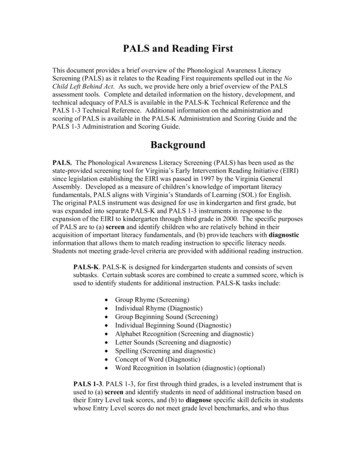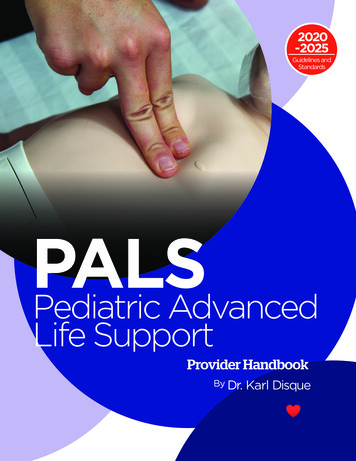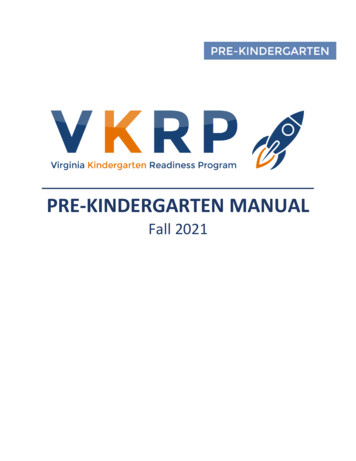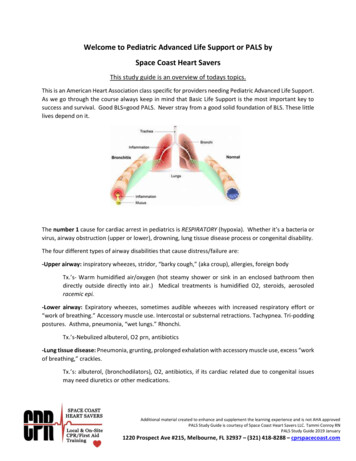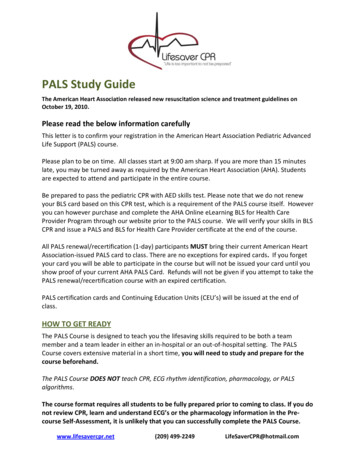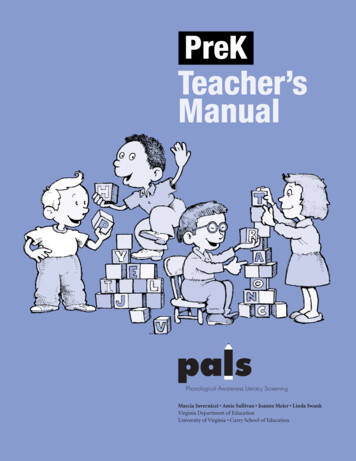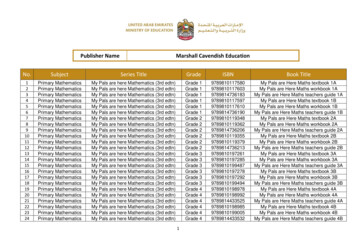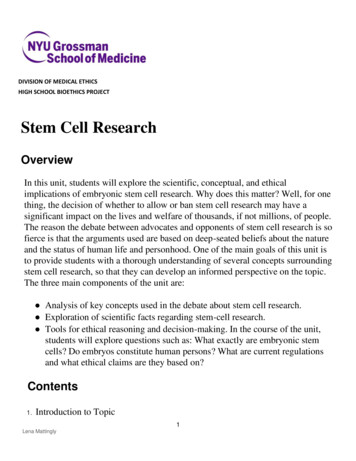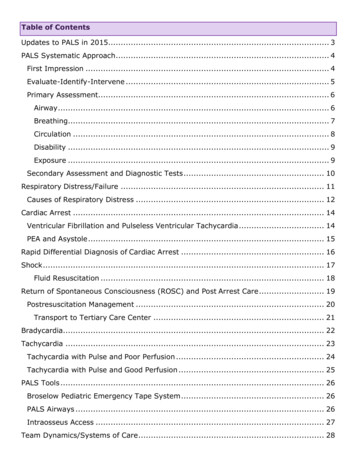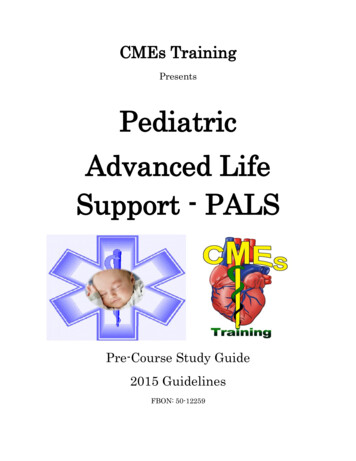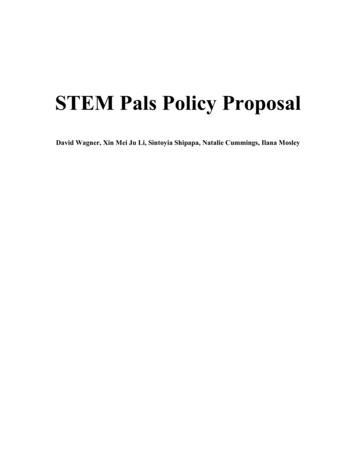
Transcription
STEM Pals Policy ProposalDavid Wagner, Xin Mei Ju Li, Sintoyia Shipapa, Natalie Cummings, Ilana Mosley
Executive SummaryIntroduction and BackgroundThe importance of a college degree cannot be emphasized enough. This is because on the greaterscale of things, college graduates earn more on average which is important in keeping up with theever increasing costs of living. This goes without mentioning a higher probability of better healthand job satisfaction. Narrowing the scope to STEM education, one of the fastest-growing careerpaths and also largely the focus of our policy, this is a very lucrative field which, unfortunately,lacks underrepresented students. The policy we therefore are proposing is the integration of STEMat the beginning of a student’s education (in elementary school) to spark an interest in these fieldswhich are both rewarding and at a deficit currently in the United States. However, despite therebeing more women than men in post-secondary education institutions, (they make up 56% ofuniversity students) they are still lagging behind in the acquisition of STEM-related degrees. Toput it in perspective, women earn only 35% of all STEM-related undergraduate degrees accordingto higher education in 2018. These statistics become even worse within minority communities:Black, Hispanic, Pacific Islander, American Indian, and other ethnic groups. There are a numberof both systemic and social factors that have contributed to this state of affairs but this policy hasbeen formulated to focus on the social stigmas associated with this area of study. The overarchingidea of the policy is the creation of an organization, ‘STEM Pals’, tasked with presenting andnormalizing diversity in STEM to elementary school students in the State College Area SchoolDistrict.The Sustainable Development goals that this policy will mainly focus on will include: Goal4: Quality Education, Goal 5: Gender Equity, and Goal 10: Reduced Inequalities. Goal 4 shall bemet by the representation of both male and female students from diverse backgrounds in STEM.1
This is especially important for women in STEM who have, over time, linked their success in thefield to a female mentor in STEM. Goal 5 shall be met by presenting female students with an equalopportunity to visualize themselves in the STEM field as individuals who are completely capableof everything their male counterparts are. Also, Goal 10 shall be met by diverse representationgiven its main focus on race. In this policy, diversity has been narrowed down to the aspect ofgender and race as these are the perceptible demarcations to elementary school children. Therefore,STEM Pals Program StructureThe STEM Pals Program will be implemented within CEEL. CEEL is an after school program inthe State College Area School District that runs for 3 hours after the end of each school day. Thiscomprises a one hour slot for enrichment opportunity that the STEM Pals programs hopes to takeadvantage of if the policy is to be implemented. Despite the State College Area School Districthaving a number of elementary schools under CEEL, we recommend the implementation of theSTEM Pals pilot program at Corl Street Elementary. This is the school at which the CEELcoordinator is based and it has a small group of students to work with. Since the focus is on STEM,the goal of this policy is to diversify the areas of STEM mostly taught in elementary school whichis robotics (mechanical engineering), biology and chemistry. This would involve the integrationof other areas such as computer science and machine learning. At the elementary school level, thiswould involve fundamental basics organized in an engaging manner to spark interest in the fieldof technology at an early age. This is because staggering differences can be seen at the universitylevel where underrepresented students comprise a very small percentage of students in STEM.Other areas of focus are electrical engineering and mathematics. Math is especially importantbecause it is a major requirement for students studying in any STEM field. Both to spark interest2
in math and to provide a strong base for other STEM fields, the goal is to keep students’ interestlong enough for these elementary school children to realize their potential before stereotypes andcultural barriers get in the way.For the successful implementation of any goal-oriented policy, funding is of the utmostimportance. Despite the Stem Pals Program being mainly dependent on volunteers to interact withthe elementary school students, its planned expansion to the other 9 elementary schools will bedependent on the availability of funds. This is because the execution of some of the STEM projectswill require materials such as circuit boards that the schools may not have in their possession, notto mention the fees needed to be paid for clearance documents so as to be able to interact with thechildren. As such, we’ve compiled a list of groups here at Penn State which could potentially serveas sponsors for the program: The Presidential Leadership Academy, The Millennium ScholarsProgram, The Schreyer Honors College, Society of Women in Engineering, Eberly College ofScience, College of Engineering, Earth and Mineral Sciences, College of Agriculture, and theCollege of Education.Rollout/ImplementationThe STEM Pals program will be an extension of the preexisting Millennium Society, thephilanthropic organization of the Millennium Scholars Program. The STEM Pals Program will beimplemented in a series of 6 phases. Phase 1 consists of establishing a structure by defining theroles of the governing bodies. Phase 2 involves defining and collecting data on the pilot school.Corl Street Elementary School was identified as the pilot school for the STEM Pals Program. Phase3 is strategic planning and preliminary course structure. This phase involves using the data3
obtained to prioritize and rank which STEM subjects should be focused on, decide how manyteachers are needed, and begin a preliminary course schedule that gauges availability and theamount of courses to be offered. Phase 4 is final review and practice. This is the shortest phase; itspurpose is to ensure that the program is ready for implementation. This phase involves assessingrisk management, proper information distribution, and obtainment of clearances. Phase 5 isimplementation which involves incorporating the STEM Pals Program into the CEEL Program atCorl Street Elementary School. Phase 6 (the final phase) is accountability. This involves collectingand analyzing the responses to the pilot, holding people accountable, and making decisions onwhat aspects of the program should be altered or eliminated. After evaluating the success of thepilot program, the STEM Pals program will first be expanded to all of the elementary schools inthe State College School District and then eventually to high schools and middle schools as well.STEM Pals Program and the Penn State CommunityGiven that ‘STEM Pals’ will essentially be made up of students from the Penn State community,these students could be drawn from different groups on campus that might show interest. The maingroup of focus will be the Millenium Society, which focuses on STEM-based community service.Other groups on campus are free to volunteer at STEM Pals. Non-stem majors could also joinbecause nothing in-depth will be taught at elementary school level. Students whose field of studyis in early childhood education will be very instrumental in the process, as well, as they can provideinsights on the theory behind the lessons we’re teaching.4
Introduction and BackgroundThe growing importance of holding a college degree in the United States is no secret. Of the 15fastest-growing industries in the country, 11 require successful applicants to possess a collegedegree (“FACT SHEET: A College Degree”, 2016). To keep up with the increasing demand forwell-educated individuals in the economy, access to higher education has risen considerablythrough scholarship money, better access to loans, and government support. From both a nationaland personal perspective, it is critical that members of the next generation adequately positionthemselves to best participate in the rapidly changing, ultra-competitive job market in a fair andequitable way. A part of this is ensuring that all individuals, regardless of all factors, have the sameopportunity to pursue success through higher education.The U.S. Department of Education says that attaining a college degree is among the best ways tomove from a low-income situation into the middle class, “especially for historically underservedstudents” (“FACT SHEET: A College Degree”, 2016). Unsurprisingly, individuals with anundergraduate degree earn on average 66% more than those with high school diplomas, whichcomes out to be an average of 1 million over the span of a lifetime. The advantage to having adegree when pursuing a career is clear. As we strive to create a more sustainable country andsociety, it is important that we consider making the path to a degree both feasible and realistic forall students. Additionally, it is important to make reasonable accommodations to ensure that allstudents feel welcome at their institutions.Importance of STEM Education5
In this report, we will be looking specifically at STEM-related fields of study. STEM, as definedby the United States Department of Education, is a rather broad category of disciplines that involveor are connected to science, technology, engineering, or mathematics.STEM is of particular interest to us because it is one of the fastest-growing career tracks. Demandfor STEM professionals is immense, and many STEM jobs go unfilled. The U.S. Bureau of LaborStatistics cite STEM employment opportunities to be growing at a rate of 13% — significantlyhigher than the 11% average (“STEM 101”, 2014). The median wage for STEM jobs sits at 76,000, which is more than double the median wage for all workers in the United States (“STEM101”, 2014). STEM is a very lucrative path.Providing underrepresented students with access to STEM education is not only a social issue, butalso an economic one. According to an Emerson survey, two out of every five Americans considerthe shortage of STEM expertise in the country a “crisis” (“Emerson Survey”, 2018). There is notenough workforce capacity to fill all of the available jobs; A report from the ManufacturingInstitute and Deloitte predicts that 3.5 million new STEM jobs will be created by 2025, and thatthe skill gap will result in as many as 2 million of those jobs going unfilled (“The Skills Gap”,2015). One of their solutions to this problem aligns with our goal: engage students in STEMbeginning in elementary school to help foster an interest in the field.Education Demographics Overview6
There are actually more women than men attending postsecondary education institutions.According to the National Center for Education Statistics, the Fall 2018 semester saw 11.2 millionfemale students at universities across the United States compared to only 8.7 million male students;this means that 56% of all university students are women (“Back to School Statistics”, 2018).Despite this, women lag behind in the STEM fields. According to the National Science Foundation,women earned approximately 62% of all associate degrees between 2000 – 2015, and yet earnedonly 44% of STEM degrees. Interestingly, according to the same report, women earnapproximately 50% of the degrees in science and engineering (which is, to note, still skewedagainst them considering that women make up 56% of the student body population), but fallsignificantly behind men in completing degrees in computer science, physics, and othertechnology-related degrees. The same phenomenon can be observed in bachelor programs where,according to the National Center for Education Statistics’ 2017 Status and Trends in the Educationof Racial and Ethnic Groups report, women earn only 35% of all STEM-related bachelor degrees(“Higher Education”, 2018).Other minority students are even worse off. While Asian and White students have the highest ratesof enrollment at colleges and universities, Black, Hispanic, Pacific Islander, and American Indianand other groups fall behind. When looking at STEM fields, this gap only widens. Black studentsare disproportionately affected, with only 11% of degrees earned by such students being STEMrelated degrees. Hispanic and American Indian students see less severe but also concerningstatistics.7
The following two figures, both courtesy of the National Center for Education Statistics 2017Status and Trends in the Education of Racial and Ethnic Groups Report, depict this discrepancy:Figure 1: Total college enrollment rates of 18- to 24-year-olds in degree-granting institutions, by race/ethnicity:2015 (NCES, 2017).8
Figure 2: STEM bachelor’s degrees as a percentage of total bachelor's degrees conferred by postsecondaryinstitutions, by race/ethnicity: Academic year 2013–14 (NCES, 2017).While engaging minority students in STEM education is a very multifaceted issue, this policypaper strives to address one contributing factor: social stigma. There are obviously many barriersto minority students considering higher education, but we have chosen this specific barrier becausewe believe it is the most actionable on a small scale.The policy discussed in this paper proposes the creation and maintenance of a Penn Statephilanthropic organization, currently under the working name “STEM Pals”, tasked withpresenting and normalizing diversity in STEM to elementary school students in the State Collegearea. The specifics of this organization’s structure, goals, and duties are discussed extensivelythroughout this paper.It is important to note that, in this policy paper, we will be defining both “diverse” and “minorities”in terms of race and gender only. Although there are many other marginalized andunderrepresented groups in higher education across the United States, we will be focusing onvisually obvious traits that are easy to notice and recognize. Our goal is to connect students with adiverse group of STEM mentors without explicitly discussing diversity with them; we hope thatby interacting with people who look like them that they may begin to normalize the idea thatanyone can do STEM. In addition to this, it is unlikely that the target age group already possessesthe maturity to grasp less obvious minority classifications.United Nations Sustainable Development Goals9
This policy, if implemented and maintained correctly, has the potential to address many of thesustainable development goals outlined by the United Nations. The most relevant of the goalsinclude Goal 4: Quality Education, Goal 5: Gender Equity, and Goal 10: Reduced Inequalities(“UN Sustainable Development”). Each will be discussed in-depth below.Goal 4: Quality Education is one of the focal points of this policy paper. Goal 4.5 states, “By 2030,eliminate gender disparities in education and ensure equal access to all levels of education andvocational training for the vulnerable, including persons with disabilities, indigenous peoples andchildren in vulnerable situations.” This goal is also outlined within this policy on a very small scale— the State College area. The aforementioned philanthropic organization STEM Pals will presentboth male and female students with a diverse representation of the STEM workforce. By dilutingstereotypes and reducing traditional social pressures and expectations, women may feel morewelcome and comfortable entering into STEM fields at the university level.Goal 5: Gender Equality is similar. Goal 5.1 states, “End all forms of discrimination against allwomen and girls everywhere, and Goal 5.5 states “Ensure women’s full and effective participationand equal opportunities for leadership at all levels of decision making in political, economic andpublic life.” Stereotypes and gender roles may not necessarily be direct discrimination, but whenapplied to institutional biases, especially in education, they are incredibly harmful and act as veryreal barriers to women’s chances of success. By not depicting women as being as capable as menin all reasonable disciplines and fields, we do a tremendous disservice to them and do not enablethem to succeed. In turn, under the current social system where women are excluded from somecritical societal functions, women cannot be expected to rise to the same leadership status as men.10
Goal 10: Reduced Inequalities focuses more on race as a factor in determining future success. Goal10.2 strives to, “By 2030, empower and promote the social, economic and political inclusion ofall, irrespective of age, sex, disability, race, ethnicity, origin, religion or economic or other status.”Similarly to Goal 5, our policy addresses this through diverse representation, and helps to teardown cultural and social barriers. Although this policy is only applicable to a specific, somewhatniche area (STEM education), it is intended to be just one piece in a much larger movement withmany other initiatives.In addition to its three main UN Sustainable Development Goals applications, the STEM Palprogram may indirectly contribute to other goals, including: Goal 2: Zero Hunger Goal 3: Good Health and Well-Being Goal 6: Clean Water and Sanitation Goal 7: Affordable and Clean Energy Goal 11: Sustainable Cities and Communities Goal 12: Responsible Production and Consumption Goal 13: Climate ActionAll of the listed goals above require extensive development in systems and technologies to beachieved, which in turn requires STEM expertise. The United States, as a world leader in STEMeducation and development, has both the capital and structural resources to contribute immense11
talent into this sphere. It is the responsibility, then, of the United States to ensure that all peoplehave access to equal opportunity to succeed so that no talent is lost due to social or financialreasons.12
STEM Pals Program StructureCEEL ProgramThe CEEL Program is an afterschool program for students attending the elementary schools of theState College Area School District. Many students are enrolled in the program, and each day aftertheir classes have ended, they spend three extra hours at their elementary school. This time includesslots for play, snacks, and enrichment opportunities, and provides an important service to studentsand families. Not only can this program act as a substitute for childcare until a point when mostguardians have finished work, but it gives students time to receive extra enrichment that CommonCore or time constraints have pushed from the normal agenda.Although the CEEL Program runs at all of the nine elementary schools in the State College AreaSchool District, we recommend the implementation of the STEM Pals pilot program at just one,Corl Street Elementary. We have chosen this location because it is a smaller school, and the schoolat which the CEEL coordinator operates. This is especially useful because this way, we have asmall group to test our program on, and if we have any questions about operating in CEEL, we caneasily communicate with the coordinator.As an established program with many attendants, the CEEL program serves as an ideal way toincorporate the STEM Pals program into the lives of students without taking away valuableinstructional time or putting additional burdens on parents or guardians.The prior existence of the program also cuts down on a lot of potential problems as a result of redtape and bureaucracy. The groundwork has already been laid; the hurdles leaped and the bridges13
crossed. The STEM Pals program can begin its existence as a part within an already successfulorganization; and even better, a program committed to quality enrichment of elementary schoolstudents.Focus AreasThe STEM Pals Program seeks to encourage everyone to feel welcome in STEM. Just as we wantto include every child who is interested, we want to include every field of STEM that we can.Many STEM programs geared toward children tend to focus on just a few fields (biology,chemistry, mechanical engineering) and end up performing essentially the same experiments againand again. We want to change this standard, and give attention to some of the fields which currentlyhave the least diversity (and which often receive less attention).Especially with some of the older students (3rd or 4th grade), we would like to present computerscience. Even considering this disparity just at the university scale, the lack of diversity of thosestudying computer science is staggering.14
Figure 3: Computer Science Earners by Race uates-diversity/).Considering the enormous gap shown in this graph, it’s clear that the group of students graduatingin computer science is not a very diverse one. We want to show kids that not only is computerscience fun and interesting, but that they can be a computer scientist, no matter who they are.We would also like to introduce electrical engineering. Doing activities or experiments withbreadboards and LEDs is safe and easy, and can be a fun way to show kids what kinds of thingsthey might see as an electrical engineer. Electrical engineering has one of the lowest rates of genderdiversity in the workforce; only 9% of employed electrical engineers are women15
/).Finally, we would like to place an emphasis on math. Math is a subject in which many studentsfeel excluded from early on, and a lack of a solid foundation in the subject can hinder participationin STEM fields further down the line, even if interest is present. We want to make sure that all thestudents know that they can succeed in math, and help to subvert the negative stereotypessurrounding the subject which are so prevalent in the media.FundingShould the program continue past a trial phase, funding would likely be necessary to continuerunning the program. Although our mentors would be volunteers, giving their time both to interactwith students and to develop plans for visits, some of the more interactive activities might requiresupplies the elementary school is not able to provide. In addition, in expanding the program to allnine of the elementary schools in the district, whatever costs there may be would increasedramatically. As such, the program ought to consider and seek funding from various sources.Although we have no guarantee that these funding sources would come through, we have compileda list of organizations here at Penn State which could potentially serve as sponsors for the program: The Presidential Leadership Academy The Millennium Scholars Program The Schreyer Honors College16
Society of Women in Engineering Eberly College of Science College of Engineering Earth and Mineral Sciences College of Agriculture College of Education17
Rollout/ImplementationDue to the lack of precedent of this policy, we plan to roll out the project in different phases. Thisway, we will ensure the project's efficiency and its ability to stay sustainable for the coming years.It is remarkably critical to make sure that we do not rush the application of the project. Otherwise,we might not be able to ensure the success of our project. Furthermore, due to the nature of thepolicy, we must guarantee a comprehensive and well thought-out blueprint. This plan aims toaccomplish one goal: to create a comprehensive scheme for the overall structure and define longterm objectives. It will serve as an outline of how the first steps of the project will be taken andthe general direction it should follow. Part of this plan will be discussed in this paper, but furtherdetails will be defined once the policy is approved and an initial team is assembled.Phase 1: Defining StructureFirst, we must define the overall structure of the project. The initial plan is to create somethingsimilar to a sub-organization, a division under an existing STEM-oriented group such as TheMillennium Society, an active organization with members from many colleges. We are seekingout an existing organization because it will be able to better provide the necessary structure andresources, making it easier to launch the project when compared to starting a student organizationfrom scratch. However, the project will still need to maintain its autonomy. One way to achievethis is by having its own leadership team, with only the head of the division reporting to TheMillennium Society. The proposed leadership structure in the division is illustrated in thefollowing graph.18
Figure 4: STEM Pals Organizational Structure.Although the structure might seem bureaucratic with many administrative positions, we believe itto be necessary because of later expansions. This structure is designed to support a teaching staffthat might be covering all nine elementary schools in the State College District. Further positionscan be added under each label as the organization size grows and the need arises.The decision of creating two major departments is to ensure that a group can focus entirely on howto create the best program for the kids, while the other can focus on how to run the organization.Each position has a clear set of responsibilities, and none of them overlap with each other. Ahierarchy structure was chosen to define more clearly the responsibility and accountability of eachposition. Each position's responsibility is outlined below.Head of divisionThis is the highest position within the program and has the duty of external spokesperson andgeneral supervisor. Its responsibilities might include but are not limited to: Communication and representation within The Millennium Society;19
Communication with other significant stakeholders during major decisions or discussions; Overseeing planning and status of different projects; Reviewing all projects' performance; Overseeing and approving major purchases; Alining short-term actions with long-term objectives.Academic ManagerThis position reports directly to the head of the division, aiming to oversee all educational projectsthe organization has taken. Its responsibilities might include but are not limited to: Overseeing projects’ advancements; Making preliminary approvals for new projects and ideas; Coordinating activities and scheduling classes; Making sure each department is following the layout plan; Planning the overall schedule for courses during the academic year.Department headsThere are four of such positions: science head, technology head, engineering head, andmathematics head. They are divided to represent each of the components of STEM. Their mainduty is to lead projects under their specific academic area. Their responsibilities might include butare not limited to: Coming up with new projects; Managing small issues that might arise with scheduling; Providing basic training for STEM Pals;20
Ensuring schedule is being met; Coordinating resources to accomplish each project; Constant revising of the syllabus.STEMPals/TeachersThese are the people who will be teaching the children involved in the programs. They report totheir specific department head and must first receive training from their department. They alsoparticipate during the planning of the courses syllabuses and schedules.Administration managerThis position reports directly to the head of the division, aiming to oversee all administrativedecisions of the organization. Its responsibilities might include but are not limited to: Creating annual budgets with treasurer; Planning and coordinating internal activities; Creating a monthly report of the status of the organization; Serving as temporal head of the organization at the absence of the president; Assigning projects to ensure short-term targets are met.TreasurerReports directly to the administration manager. Its main goal is to ensure financial goals are metand keep financial records. Its responsibilities might include but are not limited to: Creating annual budgets with both managers and the Head of Division; Monitoring and modifying budget frequently;21
Creating monthly and annual report of financial activities; Holding all financial operations records.SecretaryReports directly to the administration manager. It aims to ensure all administrative records arekept. Its responsibilities might include but are not limited to: Redacting and keeping meeting agendas; Scheduling locations for events and programs; Responsible for completing the necessary paperwork for members, including necessarybackground checks, federal provisions, etc.; Keeping all records of members of the organization.Public RelationsReports to the administration manager. It ensures a line of effective communication betweenstakeholders and the organization and is responsible for all advertising/promotion of theorganization. Its responsibilities might include but are not limited to: Creating strategic plans for advertising campaigns; Making preliminary contact and background research on potential investors; Maintaining frequent communication with CEEL; Making contact with different news sources; Maintaining social media platforms.Accountability22
Reports to the administration manager and its goal is to hold all members of the organizationaccountable, reviewing projects' efficiencies, and gathering data for future expansions. Itsresponsibilities might include but are not limited to: Evaluating the results of the various projects; Collecting and analyzing data of the organization's progress; Creating a monthly report on projects feedback; Resolving issues that arise between members of the organization; Collecting information on new potential elementary schools to expand the program into.Phase 2: Assigning Target SchoolBecause this is a new program, we plan to implement it with one sin
the State College School District and then eventually to high schools and middle schools as well. STEM Pals Program and the Penn State Community Given that 'STEM Pals' will essentially be made up of students from the Penn State community, these students could be drawn from different groups on campus that might show interest. The main
